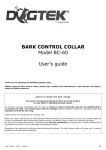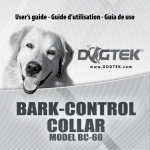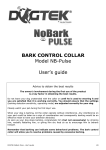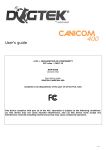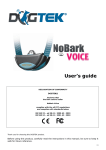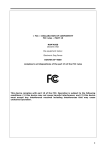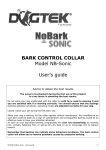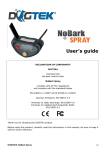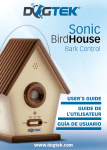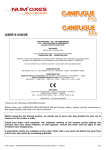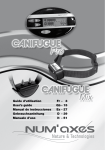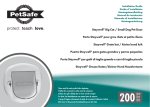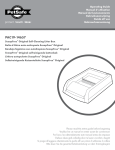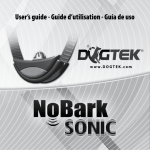Download Dogtek EF-4000 Specifications
Transcript
1 2 Table of Contents Introduction3 Contents of the EF-40003 How the pet fencing system works 3 Installing the pet fencing system 3 Automatic system5 Sample layouts6 EF-4000 transmitter7 EF-4000 receiver collar7 Adjusting the boundary range 8 Testing the pet fencing system 8 Adjusting the stimulation level 9 Safety features10 Changing the contact points10 Fitting and positioning the collar 10 Getting the best results11 Starting out with the pet fencing system 11 Cautions for use11 Maintenance12 Troubleshooting12 Technical specifications13 Warranty13 Warranty conditions13 Spare parts13 sommaire Avant Propos15 Composition du EF-400015 Principe de fonctionnement du système anti-fugue 15 Installation du système anti-fugue15 Système automatique17 Exemples d’installation18 Émetteur EF-400019 Collier EF-400019 Réglage de la portée des ondes: zone d’avertissement sonore et zone de stimulation 20 Validation de la largeur des zones 21 Réglage de l’intensité des stimulation 21 Dispositifs de sécurité22 Changement des électrodes22 Ajustement et positionnement du collier 22 Pour obtenir les meilleures performance 23 L’initiation au collier anti-fugue23 Précautions d’emploi23 Maintenance24 En cas de dysfonctionnement24 Caractéristiques techniques25 Garantie25 Conditions de garantie25 Accessoires25 indice Prefacio27 Composición del producto EF-400027 Principio de funcionamiento27 Instalación del sistema de valla invisible 27 Systema automático29 Ejemplo de instalación30 EF-4000 transmisor31 EF-4000 collar31 Ajuste del alcance de las ondas: zona de advertencia y zona de estímulo 32 Comprobación de las zonas32 Ajuste del nivel de estímulo para el collar 33 Dispositivos de seguridad34 Cambio de los electrodos34 Ajuste y posicionamiento del collar 34 Para obtener los mejores resultados 35 Iniciación al collar antifuga35 Precauciones de uso35 Mantenimiento36 En caso de malfuncionamiento36 Características técnicas36 Garantía37 Condiciones de garantía37 Accesorios37 www.dogtek.com 3 4 Installing the pet fencing system 1.Transmitter The transmitter must be installed indoors or in a sheltered dry location: the transmitter can withstand changes in temperature but will be damaged by water. Make sure the transmitter is correctly fixed (for example screw it to a wall). Install the transmitter in a garage or garden shed near an electrical outlet. 2. Antenna wire For the system to operate, the wire must be connected to the transmitter and form a continuous loop from the transmitter and back again. The outward and inward wires must be spaced at least 5 feet apart to avoid cancelling the signal. 6” 6” How the pet fencing system works You can define your dog’s play area by installing a wire, called antenna wire, around the authorized perimeter. This wire placed on the ground, buried or raised on an existing fence carries a radio signal from the transmitter. When your dog, wearing a receiver collar, approaches this wire, he is warned by beep sounds that he is too close to an area where he is not allowed; then if he carries on, static stimulations will be emitted by the collar. Your dog will have to leave the unauthorized area to stop the stimulations and beep sounds. An unlimited number of receiver collars can be used with one transmitter: you can keep as many dogs as you wish safely in the same area. Both EF-4025 and EF-6025 collars can be used. The EF-4000 pet fencing system has been designed to give you complete satisfaction with an antenna wire up to a maximum length of 2000 feet (equivalent to 5 acres). Boundary Wire Ca bl e In order to prevent any interference, do not run the wire within 6 feet or parallel to electrical cables. If you must cross electrical wires, telephone wires or television cables, do so at 90 degree angles. d collar fitted with short contact points and a strap lithium Battery CR2 3V transmitter with AC power adapter 330 feet roll of antenna wire connection kit including 3 antenna wire connectors and 1 transmitter connector set of 10 boundary flags neon test lamp pair of long contact points this user’s guide rie Contents of the EF-4000 • • • • • • • • • From the transmitter, unroll the wire around the perimeter you wish to protect. To run the wire from your garage or garden shed, pass it through a window, door or similar. The wire can be placed on the ground, buried (maximum: 4 inches deep) or fixed to a non-metallic existing fence or wall (best height: your dog’s neck height). If you plan on burying the wire, make sure your installation is functioning properly before doing so. You can protect the wire by running it through PVC pipe or a garden hose. The wire must not be taut as variations in temperature may cause it to expand or contract. In the corners, do not make any right angles but rounded corners with a large radius. Separate the wire by at least 6 feet from a metallic gate or 3 feet from a metallic fence. Do not install the antenna wire near an electrical cable, telephone cable, television cable or satellite dishes. Bu INTRODUCTION The obedience between a dog and his owner has existed since the beginning of time. Nonetheless, a dog is often guided by his natural instincts and breaks the rules his master has taught him, like straying away and causing trouble such as: damage to flowerbeds, jumping into swimming pools, etc. More seriously, he may be the victim or the cause of road accident. The EF-4000 pet fencing system is a modern and highly effective system enabling you to keep one or more dogs in complete freedom within a perimeter, fenced or unfenced, you have defined. If you need more than 500 feet of antenna wire, Twisted wires you must connect the different lengths of wire using Boundary Wire Wire connectors the supplied connectors (this wire does not need to be stripped). You can purchase additional wire and Correct connectors from DOGTEK or your retailer. To ensure your dog does not receive any warning or Incorrect stimulation in certain areas (e.g. between the transmitter in the garage and the edge of your property) you have to twist the outward wire around the inward wire. The twists prevent radio waves from being emitted. Once the loop is completed and you are back at the transmitter, strip the two ends of the wire to connect them to the supplied transmitter connector (connect each wire with each connector screw). Then, insert this connector into the antenna socket located on the transmitter. www.dogtek.com 5 • • 6 Flags The flags are a temporary visual aid for your dog during the training process. They enable your dog to visualize the area where he can move freely and the boundaries he must not cross. We recommend installing the flags at the inner edge of the warning zone at short intervals. Do not place the flags at the antenna wire. Once your dog is familiar with the boundaries, the flags can be gradually removed. SAMPLE LAYOUTS • Single Loop The single loop is the most common layout, this will allow your dog to roam your entire property. It can also protect pools and gardens. FRONT YARD FRONT YARD Layout of your installation Before starting the installation of your pet fencing system, it may be useful to draw a layout of the installation. Once the installation is completed, note the location of the wire connectors on the layout you drew for future reference. In case of connection default, you will find them more easily. BACKYARD Automatic system FRONT YARD FRONT YARD BACKYARD FRONT YARD BACKYARD FRONT YARD As soon as the animal wearing a collar enters the protected area, he is warned by beep sounds. If he continues to move forward, towards the antenna wire, the collar emits stimulations. The antenna wire is placed on the ground, buried or raised on an existing fence. For the system to function, the wire must form a continuous loop. BACKYARD Diagram 1 Sample installation Two adjustable zones WARNING AND STIMULATION BACKYARD LAKE BACKYARD LAKE BACKYARD By twisting the outward strand with the inward strand, wave emission is blocked and the animal can move freely within this zone. FRONT YARD • Double Loop A Double Loop must be used when you are not establishing the boundary zone on all sides of your property. When using a Double Loop, the antenna wire must be separated by a minimum of 5 feet to avoid canceling the signal. Remember that a Double Loop will require twice as much wire. FRONT YARD Antenna wire BACKYARD FRONT YARD Twisted wire SIGNAL CANCELED, THE DOG CAN GO BACK AND FORTH BACKYARD BACKYARD LAKE FRONT YARD ROAD www.dogtek.com 7 8 EF-4000 transmitter Potentiometer for setting the warning zone (beeps) Switch for setting the stimulation zone Diagram 2 EF-4000 Transmitter • • • on the battery housing. A beep sounds, indicates that the collar is switched on. Check that the waterproof gasket is in place on the groove of the battery cover. Before re-tightening the 4 screws, force the strap against the battery cover by pulling it. Using a screwdriver, moderately tighten the 4 screws. NOTE: During fence set up and pet training, you will put a greater than normal load on the battery. You may need to replace this original battery after 30-60 days depending on how much testing and training you do. Under normal circumstances battery life is about 6 months. Power off the collar On / Off switch Antenna socket Green indicator light showing appliance is ‘on’ Connection to power unit If the control collar is not to be used for a long period of time, the battery should be removed from its housing. If you want to take your dog off the property, you are advised to remove the receiver collar. You can also switch the transmitter to Off and the green indicator light will go out. (See Diagram #1) Adjusting the boundary range: warning ZONES and STIMULATION ZONES Power on/off the transmitter • Power On: switch the transmitter to the On position using the switch button on the left side of the unit: a green indicator light will turn on. • Power Off: switch the transmitter to the Off position using the switch button on the left side of the unit: the green indicator light will turn off. Using the transmitter, you can increase or decrease the width of the warning and impulse zone, depending on the configuration of your yard and how the antenna wire is laid. NOTE: do not turn on the transmitter before connecting the antenna wire to the antenna socket. Otherwise the wire break alarm would alert you of a connection default (ref. § Safety features). EF-4000 receiver collar contact points Diagram 3 EF-4000 Receiver Collar Button for adjusting stimulation intensity Diagram 4 EF-4000 Receiver Collar Battery position Install or replace the battery Testing the pet fencing system To intall or replace your collar battery, proceed in the following way: • Unscrew the 4 screws on the battery cover • Insert the battery (CR2) in the position indicated Before releasing your dog into his play area, you need to test the authorized zones. Make sure your dog has enough space to move freely within the defined limits. The wider the zones, the lower the escape risks. Therefore, you have to find a good median between zone width and freedom space. www.dogtek.com 9 10 In order to test the installation, proceed as follows: • Before doing so, make sure the transmitter is turned Off (green indicator light Off ). • Attach each wire of the neon test lamp under each contact point (unscrewing them lightly and retightening them so as to pinch the test lamp wires). • Turn On the transmitter. • Set the warning and stimulation zones on the levels that seem appropriate. • Stand at the center of the authorized area holding the collar by the strap at the same height and orientation as if on your dog’s neck. Then walk towards the edge of your property where the antenna wire is laid. At a certain distance from the wire, the collar should emit beep sounds. Then, when you carry on, the neon test lamp should light indicating stimulations are emitted. If you think the zones are insufficient, go back to the transmitter to modify the settings. • Use the center dial (0 to 10) to modify the width of the stimulation zone and the 3 positions button on the right to modify the correction zone (1 to 3). Check the new settings on your property. Test the settings in a number of different areas of the installation to ensure that the functioning is constant. • When the zone setting is complete, walk all around the authorized area holding the collar by the strap at the same height and orientation as if on your dog’s neck in order to check that there is no loss of signal. • Before disconnecting the neon test lamp, make sure the transmitter is turned Off (green indicator light Off ). WARNING: Do not test or adjust the system while the collar is on your dog. Adjusting the stimulation level 8 stimulation levels (modes) are available on the collar so you can adjust it to your dog (size, sensitivity, temperament). In the factory, the collar is set on mode 4. Always start with a low level of stimulation and define the level from which your dog reacts by increasing gradually. The table below indicates how your collar operates according to the selected mode: Number of beep sounds heard when switching modes Mode Stimulation level 1 2 3 1 2 3 low stimulation levels: for small dogs or dogs with sensitive temperament 4 5 6 4 5 6 medium stimulation levels: for medium dogs or dogs with average temperament 7 8 7 8 strong stimulation levels: for large dogs or dogs with stubborn temperament To change the stimulation level, the collar must be switched on (battery inserted): Opening the battery cover gives you access to the push button indicated by an arrow (See Diagram #3). To activate this push button, use a pointed object such as a pencil tip. The mode is changed by pressing and holding the push button: a number of beeps (from 1 to 8) is then emitted by the collar. Keep the button pushed in to run through the modes. Release once the desired mode is reached: the collar memorizes the configuration you have selected. Checking the selected mode: If you need to, or as your dog’s behavior changes as he becomes used to the collar you can check the mode you selected previously. A short press on the push button under the battery cover enables you to activate the beep and count the number of beeps corresponding to the mode selected (1 to 8 beeps) Safety features The EF-4000 pet fencing system comes complete with 3 safety features: • wire break alarm If the antenna wire breaks or if a connection fails, the transmitter will alert you to this operating default by emiting continuous beep sounds • warning zone timer After about 20 seconds of continuous presence in the warning zone, your dog will be signalled to leave the zone by the emission of a few short stimulations (stimulation level depending on the selected mode). • stimulation zone timer If your dog remains in the stimulation zone for approximately 20 seconds, the collar stops emitting stimulations. The normal functioning resumes when your dog leaves this zone. Changing the contact points Two different sizes of contact points are supplied. The length of the contact points must be sufficient to have proper contact with the dog’s skin, enabling the device to operate correctly. If you have a long-haired dog and the short contact points fitted to the collar in the factory are inadequate, remove and replace them with the long ones supplied with the kit. Carefully tighten them by hand (do not use a tool). Fitting and positioning the collar Fitting and positioning the collar is very important. In fact, the collar position determine the correct operation of the product (straying detection, transmission of the stimulations). To achieve best results from your system, the strap must be adjusted so that the contact points are in contact with the skin of the dog. • If the strap is too loose, the collar is likely to move and repeated friction can irritate the skin of your dog. • If the collar is too tight, the dog will have breathing difficulties. www.dogtek.com 11 12 If necessary, replace the short contact points with the long ones supplied with the kit (ref § Changing the contact points). Do not leave the collar more than 8 hours per day on your dog. Check your dog’s neck regularly. If irritations appear, remove the collar until all signs of skin irritations have disappeared. • Getting the best results • The performances of your pet fencing system will be optimal if you follow these recommendations before each use: • Make sure the collars batteries is working properly: its condition affects the proper functioning of the collar. At temperatures below 32°F, the battery is less effective than at room temperature. • Make sure both contact points are properly tightened on the collar. • Check the good fit and position of the collar on the neck of your dog. Starting out with the pet fencing system • • • • • • • • It is recommended using the collar with at least 6-month-old puppies that have already received some basic training (“stay”, “sit”, or at least “no”). Do not use the collar with dogs that are not in good physical shape (i.e. cardiac problems, epilepsy) or have behavioural problems (i.e. aggressive dog). Your dog will need to get used to the collar, for a few days let the dog wear the collar but do not turn it On. Closely watch your pet during the first days’ use. Do not rush So that your dog quickly makes the connection between the stimulation and his bad behaviour, his attention must be obtained by first warning him with the beep sounds. The flags enable your dog to visualize the area where he can move freely and the boundary he must not cross. Give your dog plenty of encouragement Let your dog start his training alone in the beggining. After the stimulation, as soon as he learns to obey and turns back, he should be patted; he will understand more quickly and his desire to obey will increase. Do not leave your dog unattended with the collar on until he is used to wearing it and you are satisfied that it is working correctly. You should ensure that the stimulation level is adjusted correctly for your dog. When your dog has fully understood the connection between the stimulation and is bad behavior, you can stop watching him, but continue to praise him at other times to reinforce his grasps of the concept of obedience. Cautions for use • • Before using the pet fencing system, we advise you to have your dog checked by a vet to ensure it is fit to wear a collar. During thunderstorms unplug the transmitter power unit from the power outlet and especially disconnect the antenna wire connector from the antenna wire socket. • • • • • • • • • • • The EF-4000 receiver collar is fully waterproof. The transmitter box is not waterproof and must be installed in a dry location (for example garage or garden shed): it can withstand temperature changes but will be damaged by water. The system activates automatically as soon as the dog enters the unauthorized zone. However, despite the product’s excellent reliability, it may be set off unintentionally. To avoid unintentional triggering, your dog should not wear a tag, metallic collar, or any other collar together with the pet fencing collar. Do not place or keep the unit in places exposed to high temperatures. Carefully check that your pet fencing system operates properly if it has not been used for some time. Do not adjust or test your product (boundary width, stimulations level) while the collar is on your dog. The collar should not be worn inside the house. The pet fencing system is a virtual boundary; you cannot consider it as a solid, foolproof barrier for all dogs. Each animal reacts to static stimulations and to training in a different way. Therefore, DOGTEK cannot guarantee that your dog will stay, in all circumstances, within the perimeter you have defined. There always will be a risk of escape. Instinct can overcome training especially when outside distractions tempt your dog (cats, other dogs, balls, bikes, neighbours,…). Your dog’s temperament may not be compatible with the product. Do not hesitate to contact a vet or professional trainer for any further advice. Keep your pet fencing system out of reach of children. Under no circumstances should you open the receiver collar. You could damage some components and alter the waterproof seal of your product. It will also void the warranty. Maintenance Avoid cleaning the collar with volatile liquids such as solvents or cleaning fluids. Use a soft cloth and neutral detergent. The strap can be washed with soapy water. Troubleshooting • • • • • • Should your pet fencing system develop a fault, first read this guide over, then check the collar battery and recharge it if necessary. Also check that you are using the product correctly. Check the fit and tightness of the collar on your dog’s neck. Make sure the contact points are in contact with the animal’s skin. If necessary, replace the short contact points by the long ones. Make sure the contact points are correctly tightened on the collar. Check the wire connection to the transmitter. Check the transmitter power supply (when the transmitter is On, the green light is on). If you encounter any problem of detection distances, check the condition of the wire and the connections (oxidation, nick in the wire). If the problem persists, contact DOGTEK. Depending on the extent of the malfunction, you may have to return your product for service and repair. www.dogtek.com 13 14 Technical specifications Transmitter Power 120 V AC power supply output 15V DC, 150 mA Waterproof seal Shower proof Temperature limitations Between 0°F and 100°F Dimensions 3.5 x 1.8 x 4.4 inches Collar Power CR2 Lithium Battery 3V Battery life about 6 months on standby Waterproof seal Waterproof Levels of stimulations 8 Temperature limitations Between 0°F and 100°F Dimensions 2.3 x 1.3 x 1.6 inches Weight (transmitter + battery + strap) 2 oz Collar adjustable to neck sizes from 8 to 26 inches WARRANTY DOGTEK guarantees the product against manufacturing defects for 1 year (conditions applies). WARRANTY conditions DOGTEK covers labor and parts for the first year of ownership; after the first year, a service or upgrade charge will apply relative to replacement or repair of the product, with new or refurbished items at DOGTEK’s sole discretion. This warranty excludes: accidental damage due to dog chews, misuse, loss, or improper handling is not covered. DOGTEK will not pay for loss of time, inconvenience, loss of use of your product, or any incidental or consequential damages. Return transport costs for the product will be the purchaser’s sole responsibility. Warranty is void if product resold. 22065 US 19 N Clearwater, FL 33765 1-800-284-2060 [email protected] www.dogtek.com Spare parts You can purchase spare parts (strap, contact points, connectors, antenna wire, additional collars …) from DOGTEK or your retailer. www.dogtek.com








